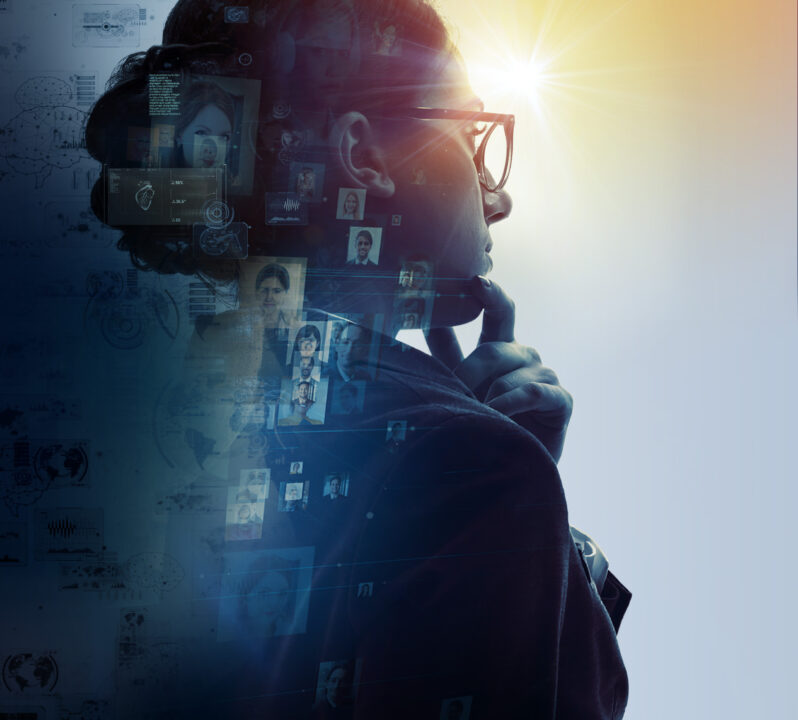In this episode of Medical Affairs unscripted, Peg Crowley-Nowick, PhD, MBA, President of Medical Affairs Consulting at Lumanity, discusses the critical role of social media listening in healthcare with Jamie Doggett, Associate Director of Social Media Insights and Analytics at Lumanity. They explore the insights obtained from Jamie’s whitepaper, Transforming Scientific Conversations: Adapting to a New Era of Healthcare Social Media. Jamie highlights how unprompted online conversations among healthcare professionals and patients can reveal critical insights for pharmaceutical companies. They delve into the usage of platforms like Twitter, Bluesky, and Threads, emphasizing the need for agility in adapting communication strategies to meet evolving digital trends.
It’s important to recognize that human behavior, whether we’re in healthcare or in anything else, shifts quickly. Cultures, trends, things go viral, and things stop. So, you need to keep a finger on the pulse as much as you can in pharma, as a really heavily regulated industry, to be adaptable to things as they change over time.
– Jamie Doggett
Podcast Series: Medical Affairs Unscripted
Hosted by Dr Peggy Crowley-Nowick, in Medical Affairs Unscripted we explore a range of topics related to the strategic role of medical affairs from the perspective of industry experts. Through these conversations with our guests we will share first hand experience to provide the listener with insights and knowledge about the evolving role of medical affairs.
Transcript
Jamie Doggett 00:01
So, it’s important to recognize that human behavior, whether we’re in healthcare or in anything else, shifts quickly. Cultures, trends, things go viral, and things stop. So, you need to keep a finger on the pulse as much as you can in pharma, as a really heavily regulated industry, to be adaptable to things as they change over time.
– Jamie Doggett
Peg Crowley-Nowick 00:26
Welcome to the 5th season of Medical Affairs unscripted. Thank you for joining us and for subscribing. I’m your host, Peg Crowley-Nowick Head of Medical Affairs at Lumanity. During this podcast, we will explore a range of topics related to the strategic role of Medical Affairs from the perspective of industry experts. Through these conversations with our guests, we’ll share first-hand experience to provide the listener with insights and knowledge about the evolving role of Medical Affairs. Please stay tuned at the end of the podcast to learn more about Lumanity.
Peg Crowley-Nowick 01:12
I’m joined today by my colleague, Jamie Doggett, who’s an Associate Director of Social Media Insights and Analytics with Lumanity. He recently published a whitepaper entitled Transforming Scientific Conversations: Adapting to a New Era of Healthcare Social Media, and from my perspective in Medical Affairs, it’s a very important topic that our clients are very interested in. So, I thought it was important to bring Jamie to our podcast, to Medical Affairs unscripted, to have a conversation about his publication and the area of social media listening.
Jamie, welcome. I’m looking forward to speaking with you.
Jamie Doggett 01:56
Thanks for having me, Peg. It’s lovely to be here.
Peg Crowley-Nowick 01:59
Today we’re going to talk a little bit about the transformation of your career and how you landed here at Lumanity, as well as talk about the experiences you’ve had in the insight and analytics area.
Jamie Doggett 02:17
Oh, happy to speak to that. I got into social listening as a market research discipline in healthcare, specifically from the beginning of my career. I’ve always been providing social research to healthcare companies, pharmaceutical companies particularly. I’ve spent many years specifically focused on studying the online communities and conversation of healthcare professionals and how they interact, who influences them, and how they use the online space to influence one another, and to influence decisions and policies.
Since joining Lumanity last year, I’ve been additionally quite focused on the patient communities and listening to the patient voice online and looking to understand what insights can be derived from their lived experience, the burdens they experience, and perhaps what even they need help with.
Peg Crowley-Nowick 03:15
Interesting. So, when we’re talking about social media listening, we’re not just thinking about healthcare providers, but we’re also thinking about the patients. And, from this information you can really start to understand the gaps that some of our clients have, whether it’s in the data sets or in even in their thinking about the patient and the patient journey.
Jamie Doggett 03:36
Absolutely.
Peg Crowley-Nowick 03:38
Well, today there are three topics that I’d like to discuss. The first is social media listening in the pharma space. What does it really look like and why is it important to think through those pieces? What are the platforms used today? How is that changing? How do you handle the social media listening space when IT is going through such a transition? All of these are topics that you discuss in a more detail in your publication, but I think it’s nice to have a good conversation about it. So maybe you could start by talking about social media listening and what you do.
Jamie Doggett 04:17
So, social media listening in many ways involves looking at social conversations on the Internet, so as soon as forums started to emerge in the digital space, if you wanted to understand something from those forums, draw some insight from those, that in its early infancy, that was the extent of social listening and what we see now as the discipline has developed over many, many years, is healthcare companies, pharmaceuticals, using social media listening as a research methodology that can sit alongside qual and quant methodologies to derive insights. I think the main thing to say in terms of the way it stands apart from those and sits as a part of that research mix is that the very nature of it is unprompted, whereas we’re not directly asking questions in an interview or by a survey, but we’re potentially passively listening to what’s naturally important to the online community, whether that be patients or healthcare providers, and seeing what occurs in their conversations, which parts of the latest news or parts of their own lived experience or journeys they want to comment on.
Peg Crowley-Nowick 05:31
My audience is probably wondering why we’re talking about this from a Medical Affairs perspective when that seems much more like a commercial marketing type of research that would get done. But from my perspective, what I see is the need to understand that patient lived experience, understand the gaps and the conversations that are going on in social media to help decide on the next level of research, integrated evidence planning and recognize what’s actually happening with the boots on the ground, and I would say that we’re doing it in a different way. We tend to run a lot of advisory boards from a Medical Affairs perspective, but there’s still a bias in running an ad board because you’re focused on where you’re going and asking questions to make sure that you’re somewhat in the right direction. It feels to me that the social media listening is a little bit more open, and you’re actually hearing what people are thinking without the bias that you bring to the table. Is that the way you think about it?
Jamie Doggett 06:34
That’s right. It’s about the unknown unknowns in that what market research can do is answer the questions of the known unknowns. So, we know we don’t know, and we need to ask questions to ascertain knowledge or insight in that space. Social listening would be more about actually there are some things that we don’t know but that we’re not aware of how to ask questions around them because they’ll come up without our prompting. When I started out almost a decade ago, I was working predominantly with commercial teams, with brand managers, marketers. But actually, over time, and especially through the pandemic, there was a massive interest coming in from medical teams and we’ve been working a lot with medical since and I think Medical Affairs have started to see the value that you can draw from hearing a bit more unscripted in the sense of what doctors really think and feel, and also auxiliary roles, who are really at the, as you say, boots on the ground when you’re hearing from nurses, their experience caring for patients or from patients directly themselves. There’s a lot of value that can be found.
Peg Crowley-Nowick 07:44
I like to think of myself as somebody who’s on top of the trends and what’s happening, though I have to admit, when I read your paper it took me by surprise thinking about the journal clubs, thinking about digital faculty, realizing the level of organization that has taken place in the social media space that maybe I was kidding myself and didn’t dig into deep enough to understand but could you talk to us a little bit about how social media is being used to educate and to engage?
Jamie Doggett 08:16
Sure. I mean those two examples link really nicely to that question. Journal clubs are actually hundreds of years old in which physicians and scientists would get together to discuss the latest academic or scientific journals and debate them and share that knowledge with one another and the idea behind the online channel club would be very similar but set in the digital space. So, they started out predominantly on Twitter and were often called Twitter Journal Clubs, and it would be often run by a key healthcare professional or perhaps a patient advocate group with a time and place. They would bring the latest papers often related to their discipline and discuss it, but online through Twitter threads and this kind of thing. And actually, one thing we talk about in the paper is then seeing how that’s now starting to divulge across platforms where Twitter used to be the mainstay for journal clubs and now, we’ve seen them hosted on various other platforms as well.
Peg Crowley-Nowick 09:19
So, what I’m hearing from you is how important it is to understand the digital space, to go beyond probably what I’m doing, which is just following a few of the thought leaders and maybe reading on some of the topics but not diving in as deep as you are on a regular basis, and then to understand maybe the unique communities that build up around the therapeutic area. So, oncology, nephrology, cardiovascular as just a just a few of the examples and it sounds like Twitter was the place that started this, the Twitter space and now that it’s X, there’s been some transition that’s happened over time, as you mentioned in the paper, and there are multiple platforms that are being used which fractionates some of the data and probably makes it a little bit more complicated for you. Could you tell me first about the different types of platforms that you’re following and what are some of the differences between those?
Jamie Doggett 10:17
When we’re listening to what’s happening in scientific conversation, we can track any sort of public social media but what we’ve found, certainly within the healthcare community, is that Twitter has been the home that was actually often called the digital town hall or the digital square, where anybody can come together, and by design, the platform was very open. You could find and follow anyone and engage in conversation with them which really broke down the barriers of geography, seniority, and specialties, and this kind of thing. But, as you say, there’s been a few changes over the last few years. There’s still a thriving community and I would say that actually the healthcare community has been in a little bit of a bubble, separate from some of the quite major changes to Twitter so it’s still a really important channel in that sense. But, as you say, a few other channels have arisen as some people have some discontented with what they were seeing on Twitter. So, when the changes first started occurring with the acquisition in 2022 by Musk, we saw a number of people trying to move to Mastodon. Mastodon, as a platform, we saw that people found it a bit too confusing. It used what’s called a decentralized structure and that means that you didn’t just sign up to one network, that there were actually different servers, and you had to find a server and connect with people across servers and there were a few other elements that made it hard to build community. But later on, there was Threads, and Threads was interesting and still is because there’s a huge number of users on Threads. Threads is part of Meta which is Facebook and Instagram and WhatsApp. So, it with one click and you could create a Threads account. So, a very large number of people with either Facebook or Instagram or both just click to sign up and many of us, myself included, have Threads accounts, but may not be particularly active. So, the question for Threads is around how many of those users are actually active per week or per month, and again, just through the research, what we discovered was that one of the main drawbacks with Threads was there was not a great deal of recency to the newsfeeds, whereas with Twitter, it would offer the audit chronologically and with Threads, it was really hard to discover actually what’s happening right now, what’s the breaking news if something is happening around the world or there’s a new article published, it will not be at the top of your feed. As a physician, you might want to see that later search, but they were struggling to get it through Threads. So, the article then focuses on Bluesky and to see actually how that might be learning from some of the shortcomings of these other platforms that, in a sense, try to take audience away from Twitter, but didn’t say much so then we sort of land on how Bluesky is starting to build some momentum going into this year.
Peg Crowley-Nowick 13:20
So, just to just to be clear, the way Twitter, which is now X, was structured, it actually made it easier for professionals to engage and to have breaking news hit your newsfeed quickly and be able to see that and it was set up that way even though there were a lot of social aspects to the platform but there was definitely enough professionalism within Twitter to make that work. Threads is more of a social platform with the population that comes across from Facebook and Instagram versus some of the professionals that we’re probably engaging with from the healthcare professional side. And now you have Bluesky, which has many of the positive features of what is now X but is still developing itself from an audience perspective and from, I would imagine, the groups and the communities are still being built on Bluesky. Is that correct statement?
Jamie Doggett 14:18
Yeah, absolutely. It’s still comparable. It still quite small. Although the last time I checked it’s at 33 million users so it’s not negligible but compared to where Twitter is, in terms of its numbers, it’s still the smaller platform but it does somewhat return to Twitter’s roots and is often cited to be much like Twitter of the old days or Twitter circa 2009 sort of thing.
Peg Crowley-Nowick 14:47
Let’s put some numbers around how many users there are on X. What do those look like on a monthly basis compared to where Bluesky is today?
Jamie Doggett 14:56
So, Twitter is still very much the big brother platform. There’re over 600 million monthly active users on Twitter according to our metrics. So that is 600 million accounts that log in each month, whereas Bluesky, as I said, had about 33 million total accounts. So, it’s a small number, but still growing and we’ll have to wait to see how much of the overall slice of the pie it will take. While it is still small in terms of the number of users, I did see an interesting piece produced by Altmetric last week where they brought data forward showing that in the month of March of this year, Bluesky was hosting more links on more days, posting to new research, than X or Twitter. So, it may well be that while it’s still much a smaller platform overall, it seems that anecdotally, using this evidence, that the scientific, the medical, and the research-based community might be choosing to move more than the average in that sense.
Peg Crowley-Nowick 16:09
And so the bottom line for people is the fact that X is still the largest platform.
Jamie Doggett 16:16
Absolutely.
Peg Crowley-Nowick 16:18
But Bluesky is there, and you can’t ignore Bluesky. Or if you miss out, you may miss out on some very important information and all of that now contributes to the additive complexity to social media listening.
Jamie Doggett 16:30
It does.
Peg Crowley-Nowick 16:31
Excellent. So, we have a slow transition, not a full transition, which I think probably makes it a little bit more challenging for both the users and our clients who are trying to understand how to participate, how to listen. Before we dig in too much further though, I’d like to ask a question more about the digital thought leaders. Are you seeing that the top thought leaders have switched over to Bluesky? Is it a just a slow movement of anybody and everybody or what are you thinking about from that perspective?
Jamie Doggett 17:08
That’s a big question and actually something we were asking towards the end of last year. So, what we did is we looked at SABCS, which is a breast cancer congress in San Antonio, and we wanted to understand which were some of the top thought leaders, who very traditionally would use Twitter and get a lot of traction there on their accounts, were going to be using Bluesky or both. So, we tracked the OncoAlert Faculty. So OncoAlert is one of the most influential networks in oncology and they seek to amplify key voices. They promote collaboration, but they do it through social media, by and large, so we tracked to see Oncoalert faculty over the course of SABCS, and we found that most of the members of the faculty used their Twitter accounts to engage in the symposium and about half of them were using Bluesky accounts. Of the faculty, five of them already have over 1000 followers. So, as you say, it’s a slower move over. It’s not that people have completely abandoned Twitter. All of those that were using Bluesky are still using Twitter sort of hand in hand, if you like. Perhaps it’s a case of let’s go for this new platform. Let’s try it. Let’s test the waters. But of course, the nature of social media means you can just continue using as many platforms as you have the time for in that sense. Even those that were using Bluesky posted a bit more, in terms of frequency of posts, on Twitter. So, some of them might just be testing the waters but we saw key oncologists and patient advocates shifting over to Bluesky along with their main place, Twitter.
Peg Crowley-Nowick 18:53
Well, it’s interesting because this seems as though it may make things a little bit more complicated from our clients’ side of doing some analysis of thinking about this, because now you need to make sure that you’re not duplicating the posts as you’re looking across different platforms and your analytics have to take into account that maybe there’s a slight difference as they’re posting on the two platforms. How do you approach that and what does that look like from your support of clients?
Jamie Doggett 19:26
Yeah, that’s a good point that we we’ve got to view individuals in social media as exactly that, they’re individuals, they’re humans. While most of us who are doing social media analytics have a passion for big data because of the nature of it, we’re going to be playing with some really big numbers and lots of big text-based data. We’ve can’t forget that there is a human on the end of those and if that human is saying the same thing twice, those sorts of things will be taken into account. There’re methods around pairing up accounts and deduplication of posts to make sure we’re not over amplifying something so say if there’re a few individuals that are particularly active or noisy, if you like, and they use even more platforms, were going to be artificially exaggerating the level of noise they’re making on top of the fact they may already be noisy. So yeah, having to pare that back to be more realistic to how many people have a certain opinion, thought, or question is important.
Peg Crowley-Nowick 20:36
So, it’s all calculated into the analytics and your thinking on the topic, as you break into this.
Jamie Doggett 20:43
At this moment in time, it is something that we would have to bring into the team here at the Lumanity. There aren’t really the capabilities around the social listening tools out there to marry up profiles across platforms and essentially say if this is the same person and they’re on two platforms, just give me one of the posts. So, it’s the post data collection piece of analysis that we would do but in some instances it’s really important for the client’s sake. We look to do that.
Peg Crowley-Nowick 21:14
So from my perspective, that’s why I love working with your group so much, because I find that you’re always thinking about the details of where the field is going, what the future is, what the challenges are, and the in-house team is always able to evaluate things at another level than just using tools that are online and that’s what I try to tell my clients, that we’re talking about the digital space, social media listening, and then starting to understand more about the digital opinion leaders and how important they are to your business, that Lumanity has tools that go much deeper than what I’ve seen with other companies. So, I enjoy learning more all the time and I’m still a little struck about how much is really going on in this space and how, from a Medical Affairs perspective, we need to dig deeper to understand who’s communicating and recognize that those are not always the thought leaders that we’re accustomed to dealing with and you’ve made it a little more complicated by adding more platforms and working through this but if we don’t step forward and start engaging differently with the digital thought leaders, then you could really lose ground in the space from a Medical Affairs perspective. I know that’s not a question. That’s more of statement but what do you think is the most important thing for our clients to know as they’re starting to think about all these platforms and how it impacts their strategy?
Jamie Doggett 22:56
I think the first place to start would be to find out for you, in your space, your therapy area, where you currently are in terms of attention to a product life cycle or whatever you’re taking care of. Should this impact your strategy? The only way to know whether any of these new platforms, not just Bluesky, would be to undertake some research around your target group, whether that be a group of physicians or patients, or what have you. Are they on any of these platforms? Are they saying relevant things? Are they showing relevant information? And if they are, and I would say with Bluesky, likely they are, then it does need to inform what your research strategy looks like this year and going forward, because you’ve got to be listening to where your customers are and what they’re saying. We’re no longer in the era where, especially with healthcare professional research, you could listen to Twitter and probably capture 99% of the conversation. It’s now shifted such that we have to be broadening that out and, secondly, you’ve got to be considering, as to your point earlier about key opinion leaders and digital influences, digital opinion leaders, where they intersect and I sometimes like to think of it, I think it was with a it was definitely with a Medical Affairs professional that I first started to visualize a classic 2 by 2 grid with digital influence on the bottom and traditional influence up the side and starting to think well potentially who are these people who hold a great deal of influence online and are starting to shape people’s thinking and may not be on the radar from a traditional point of view? But just as importantly, in some therapy areas, it’s thinking about some of those key opinion leaders so high on the Y axis also have a greater digital influence and they’re sitting in that top right quadrant. For the two by two in that analogy, and they are at the same time as putting great scientific information out there, getting published in journals, speaking at conferences, they’re then posting multiple times a day on digital social platforms to thousands or even tens of thousands of followers and that science is immediately going all way around the world to a huge audience, often a predominantly healthcare or even, you know, physician audience. And there’s a really important communication and partnership strategy that can be built around those kinds of individuals as well.
Peg Crowley-Nowick 25:34
I think it’s really important what we did yesterday is not going to take us into the future and understanding this space is just as critical from a Medical Affairs perspective as it is from our marketing and commercial organization. Are there any recommendations that you have just to finish off for companies as they’re thinking about these three different platforms or two different platforms, if X and Bluesky are really the future, that they should think about in their engagement in their research?
Jamie Doggett 26:10
Yeah, absolutely. First, I’d reiterate, you’ve got to be tracking all platforms. Be sure that whether you’re doing this in-house or using a company like Lumanity, make sure you’re getting the best coverage, especially in that healthcare setting, it’s important to make sure we know where patient or physician groups are meeting. Secondly, once you get that information back, analyze the strengths and weaknesses of each platform for your target audience. And we’re thinking about, with our clients, how to help them tailor communication strategies whether that’s them actively communicating with platforms or partnering with people on platforms. And as always with social media, a key point, is to stay agile and stay adaptive because things are moving really fast. Things are very fluid right now, and as I referenced a couple of other platforms, they did seem to be gaining traction a year back or even 2 years back for another and then somewhat fizzled out. So, it’s important to recognize that human behavior, whether we’re in healthcare or in anything else, shifts quickly. Cultures, trends, things go viral, and things stop. So, you need to keep a finger on the pulse as much as you can in pharma, as a really heavily regulated industry, to be adaptable to things as they change over time.
Peg Crowly-Nowick 27:39
Absolutely, and great pieces of advice. From my perspective, the last couple of things that I would say is that it’s really important to think about social media listening as you’re building your integrated evidence plan. There’s a very great possibility that you will hear about gaps in the communications that are going on in a very large community and it gives you an opportunity to think about those gaps a little bit differently. When we’re talking about communication points it’s certainly very interesting to see if the way the company is thinking about the communication points are those expressed and validated through social media, and it certainly is a way to start thinking about what you’re saying and how well your communication plans are working. And then the last is it reemphasizes the importance of a strong publication communication plan.
Jamie, this is a great conversation. I enjoyed your paper.
I am going to spend a little bit more time on social media to make sure that I have a better grasp of all that’s going on in the healthcare space so that I can continue to advise my clients, and I look forward to collaborating with you as we have in the past with your team.
Thank you very much for joining the call.
Jamie Doggett 29:00
Thanks very much Peg. I really enjoyed it.
Peg Crowley-Nowick 29:05
At Lumanity, we focus on improving patient health by accelerating and optimizing access to medical advances because it’s so important for patients to have access to life changing innovations. We provide consulting and strategic services to Medical Affairs organizations. Medical Affairs programs designed by Lumanity can help you recognize the most important insights from your in house and field teams and then capitalize on that data to develop strategic Medical Affairs plans that strengthen your engagement with thought leaders and build cutting edge data generation programs. Success in these areas allows the medical team to provide leadership and demonstrate maximum value to your brand and organization. Now, as Lumanity, our clients can also benefit from broader capabilities and expertise across commercial, market access, real world evidence, HEOR, and communications. Lumanity is here to help you. You can reach us at MA-Info@lumanity com. That’s Lumanity, L-U-M-A-N-I-T-Y.com.
Episode guest

Jamie Doggett
Associate Director, Social Media Insights and Analytics, Lumanity












